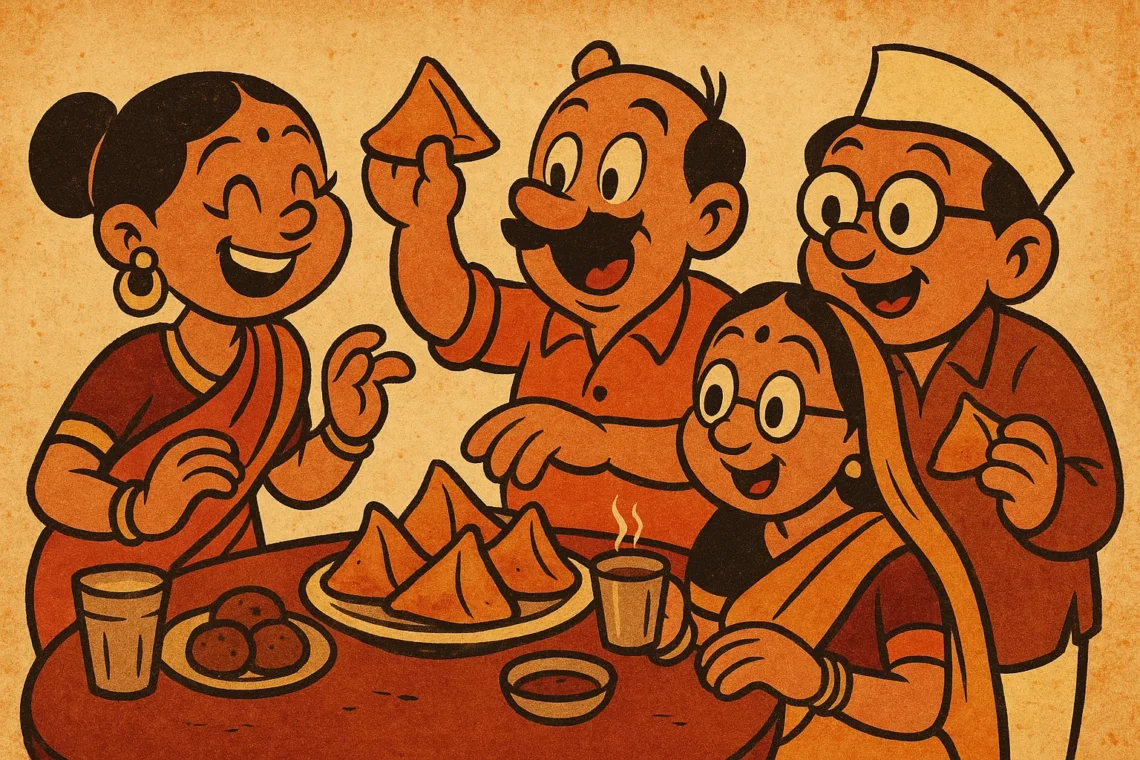If you’ve ever found yourself hovering around the office pantry at exactly 4 PM, waiting for that golden moment when the snack trolley rolls in, you know exactly what I’m talking about. The time is sacred. It’s not just any snack time; it’s the unofficial office politics hour — a period where even the humble samosa becomes a symbol of office dynamics. In that brief window, where hunger meets diplomacy, every bite counts. Welcome to the world of office snack politics, where the rules are unspoken, but very real.
The Ritual of the 4 PM Snack
There’s something oddly comforting about the 4 PM snack break. The whole office knows it’s coming, but no one says it out loud. It’s a quiet understanding. The email alerts might stop, meetings wrap up, and the hum of typing slows down as people file in to the break room. Some might grab their laptops for that final push of the day, while others simply stare longingly at the snack trolley. The samosas are always the star, but let’s not forget the pakoras, the chips, or the occasional fruit. It’s not so much about what’s on the trolley; it’s about how you navigate the delicate balance of getting your share without looking too eager.
The One-Samosa Rule
In every office, there’s a rule that’s never written down, but somehow, everyone knows it: The One-Samosa Rule. The rule is simple — no one person should take more than one samosa at a time. It’s an unwritten code of fairness. Why? Because the samosa represents much more than just a snack. It’s a test of your office savvy, your ability to gauge the room, to understand the fine art of shareability. Too many samosas in your hand, and you risk making yourself the target of collective judgment. Too few, and you’ll be seen as weak, an easy mark for that one overzealous colleague who’s got no shame when it comes to stacking up samosas.
The One-Samosa Rule works on the simple premise of balance. You don’t want to be the one who scoffs down a plateful, but you also don’t want to walk away with a single samosa, leaving the rest to look at you in pity. It’s the office snack equivalent of walking the line between self-preservation and social grace. A single samosa in hand, savored slowly, allows you to look just the right amount of casual. It says, “I’m hungry, but I’m also in control.”
The Politics of Proximity
The most critical aspect of office snack politics, however, is positioning. It’s not enough to simply get to the snack trolley first — you must claim your spot wisely. Standing too close to the trolley may make you look greedy, but standing too far away can make you look like you’re trying too hard to be modest. The sweet spot is somewhere in between, just close enough to make a swift move without drawing attention. And then there’s the art of making small talk while holding your samosa. Do you chat with your boss? Do you make small talk with the HR rep who’s always standing awkwardly in the corner? Or do you just nod in passing and pretend the samosa is enough of a distraction to avoid all conversations?
The Samosa and The Status
The samosa, in all its crispy, spicy glory, is also a subtle indicator of status. The more senior the employee, the more likely they are to pick the first samosa and quietly slip away to their office, giving a courteous nod of acknowledgment. Junior staff, on the other hand, hover around the trolley, eyes darting to see who’s taking what, assessing whether they can grab a second samosa without stepping on anyone’s toes. The risk? Losing the battle for that last samosa when the trolley makes its rounds.
But let’s be honest — no one can deny the power of that first bite. It’s not just about eating; it’s about how you navigate the office snack hierarchy. The decision of whether or not to claim your share of samosas becomes a mini power play. It’s a silent negotiation that happens every afternoon and one that can define your office persona more than you might think.
The Unspoken Social Dynamics
Beyond the one-samosa rule, there’s an unspoken social contract. If you’re the one who brought in the snacks, you’re automatically the most powerful person in the room. No one questions your decision to take two samosas, no matter your rank. The power shift that occurs when someone brings in snacks — especially samosas — is like watching a social experiment unfold. People will suddenly become unusually nice, smiling with a slightly too eager energy, all while reaching for their single samosa, playing by the rules.
The End of Snack Time: What Happens Next?
As the snack trolley rolls away, the office politics of 4 PM wind down. The tension dissipates as people shuffle back to their desks, content for the moment. But the power of that brief, 15-minute interlude lingers. Who got the last samosa? Who skipped out early, pretending to be “too busy”? The unspoken social contracts have been tested, and you’ve either passed or failed. The politics of the office snack break are small, but significant. As we return to our screens and get ready to wrap up the day, we remember that snack time is, for a brief moment, a place where hierarchy, fairness, and camaraderie all coexist in the form of a perfectly spiced samosa.
Snack Time as Office Ritual
In the end, the 4 PM snack break and the One-Samosa Rule encapsulate much of what makes office life interesting: the complex web of interactions, the balance between politeness and personal gain, and the simple pleasure of food. So, the next time you find yourself in the break room, consider the humble samosa not just as a snack, but as a symbol of your place in the office pecking order. Enjoy it, savor it, and remember — it’s not just food; it’s part of the office ecosystem.
Born in Mumbai, now stir-frying feelings in Texas. Writes about food, memory, and the messy magic in between — mostly to stay hungry, sometimes just to stay sane.












